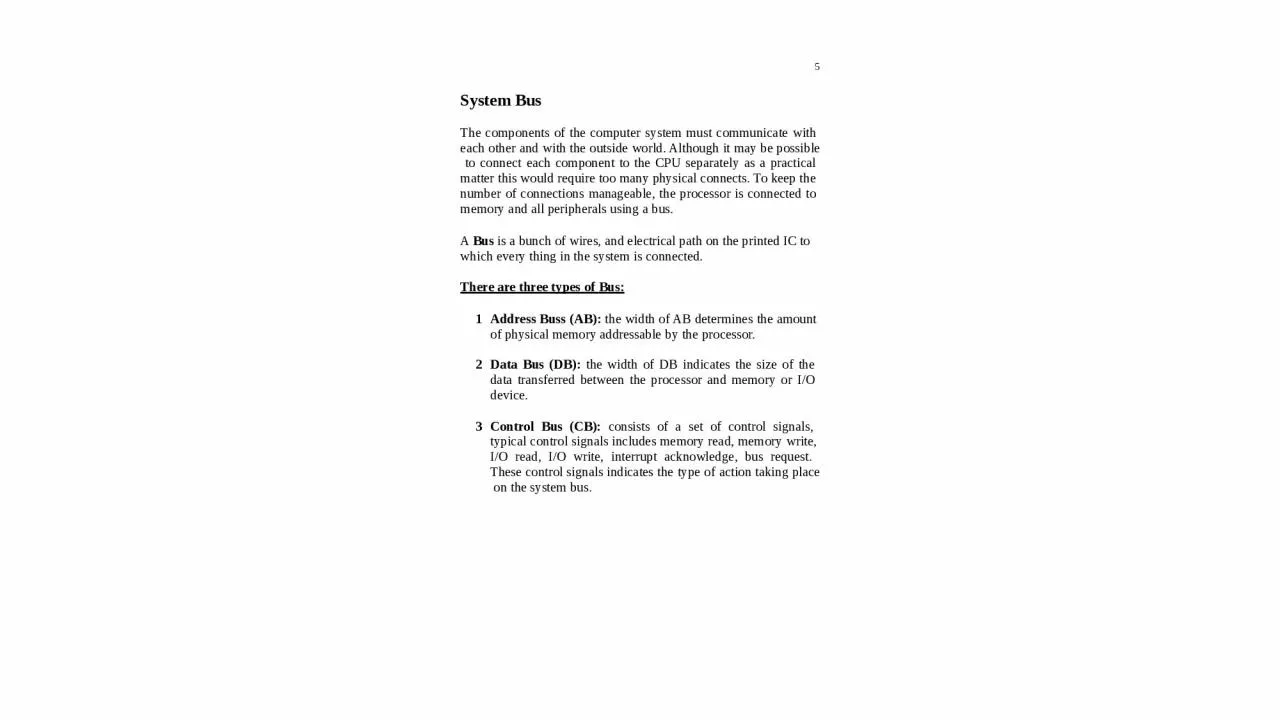

system must communicate with each other and with the outside world Although it may be possible to connect each component to the CPU separately as a practical matter this would require too many physical connects To keep the ID: 1030999
Download Presentation The PPT/PDF document "5 System Bus The components of the compu..." is the property of its rightful owner. Permission is granted to download and print the materials on this web site for personal, non-commercial use only, and to display it on your personal computer provided you do not modify the materials and that you retain all copyright notices contained in the materials. By downloading content from our website, you accept the terms of this agreement.
1. 5System BusThe components of the computer system must communicate with each other and with the outside world. Although it may be possible to connect each component to the CPU separately as a practical matter this would require too many physical connects. To keep the number of connections manageable, the processor is connected to memory and all peripherals using a bus.A Bus is a bunch of wires, and electrical path on the printed IC to which every thing in the system is connected.There are three types of Bus:Address Buss (AB): the width of AB determines the amount of physical memory addressable by the processor.Data Bus (DB): the width of DB indicates the size of the data transferred between the processor and memory or I/O device.Control Bus (CB): consists of a set of control signals, typical control signals includes memory read, memory write, I/O read, I/O write, interrupt acknowledge, bus request. These control signals indicates the type of action taking place on the system bus.
2. 6Personal Computer (PC) ComponentsThe main component of the PC is its System Board (or mother board). It contains the processor, co-processor, main memory, connectors, and expansion slots for optional cards.The slots and connectors provide access to such components as ROM, RAM, hard disk, CD-ROM drive, additional memory, video unit, keyboard, mouse, parallel and serial device, sound adapter and cache memory (the processor use high speed cache memory to decrease its need to access the slower main memory). A bus with wires attached to the system board connect the components. It transfers data between the processor, memory and external devices.The processorThe CPU or processor acts as the controller of all actions or services provided by the system. The operations of a CPU can be reduced to three basic steps: fetch, decode, and execute. Each step includes intermediate steps, some of which are:Fetch the next instruction:Place it in a holding area called a queue.Decode the instruction.Decode the instructionPerform address translation.Fetch operand from memory.Execute the instruction.Perform the required calculation.Store results in memory or register.Set status flag attached to the CPU.
3. 7Figure 2 shows a block diagram of a simple imaginary CPU. The CPU is divided into two general parts. Arithmetic Logic Unit (ALU) and Control Unit (CU).The ALU carry Arithmetic, logical, and shifting operations.The CU fetches data and instruction, and decodes addresses for the ALU.Figure 2: A block diagram of a simple CPU.B. MemoryThe memory of a computer system consist of tiny electronic switches, with each switch set in one of two states: open or close. It is however more convenient to think of these states as 0 and 1.Data RegisterAddress RegisterMemoryCUALUData BusAddress Bus
4. 8Thus each switch can represent a binary digit or bit, as it is known, the memory unit consists of millions of such bits, bits are organized into groups of eight bits called byte.Memory can be viewed as consisting of an ordered sequence of bytes. Each byte in this memory can be identified by its sequence number starting with 0, as shown in Figure 3. This is referred to as memory address of the byte. Such memory is called byte addressable memory.8086 can address up to 1 MB (220 bytes) of main memory this magic number comes from the fact that the address bud of the 8086 has 20 address lines. This number is referred to as the Memory Address Space (MAS).The memory address space of a system is determined by the address bus width of the CPU used in the system. The actual memory in a system is always less than or equal to the MAS.Figure 3: Logical view of the system memory220-1210FFFFF FFFFE000020000100000...Address in DecimalAddress in Hex